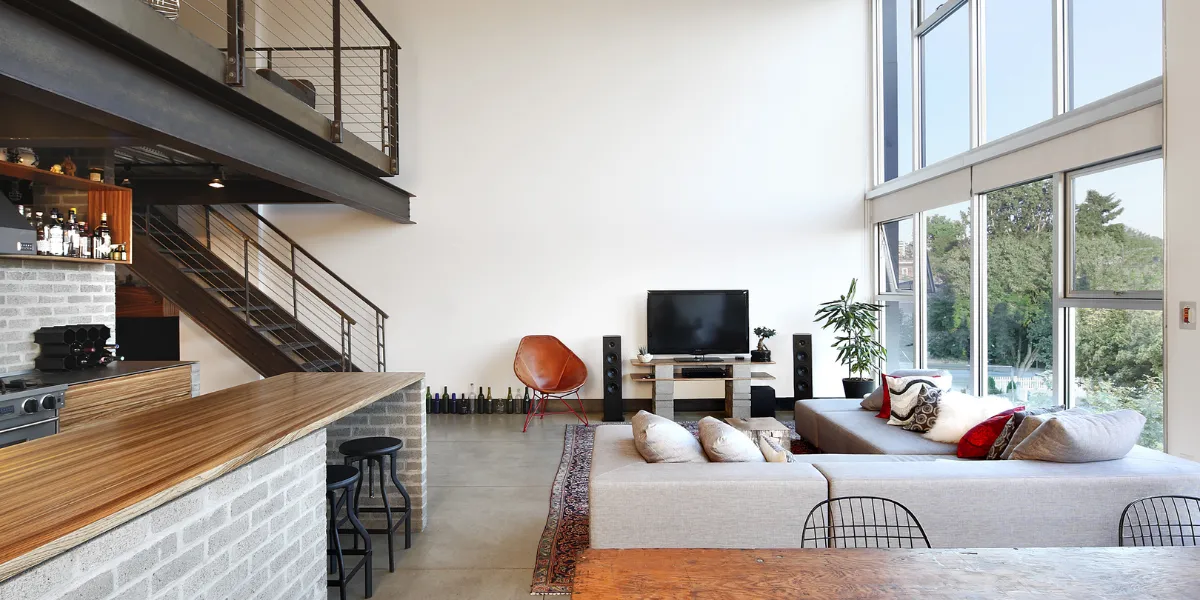Location and Accessibility: Assessing the Neighborhood’s Convenience

Things To Consider Before Investing In A Loft In Toronto geographical positioning of a loft within Toronto and how easily accessible it is to various amenities and transportation options. “Location” refers to the specific area within the city where the loft is situated, considering factors like proximity to downtown, entertainment districts, parks, and schools. “Accessibility” encompasses the ease of reaching essential services, such as grocery stores, pharmacies, restaurants, and public transportation hubs.
Assessing the neighborhood’s convenience involves evaluating how well the location aligns with your lifestyle needs and preferences. Factors such as walkability, public transit options, availability of bike lanes, and traffic congestion play a crucial role in determining the convenience of the neighborhood. Additionally, considering future developments or infrastructure projects that might enhance or detract from accessibility is also important in making an informed investment decision.
Budgeting Beyond the Purchase Price: Hidden Costs to Anticipate

This heading underscores the significance of planning for expenses beyond the initial purchase price when investing in a loft in Toronto. While the purchase price is a significant financial consideration, there are several other costs associated with buying and owning a property that buyers should anticipate and budget for.
“Budgeting Beyond the Purchase Price” implies the need to think beyond the immediate expenditure involved in acquiring the loft. This includes costs such as closing costs, legal fees, land transfer taxes, and home inspection fees, which are often overlooked but can add up substantially.
“Hidden Costs to Anticipate” draws attention to expenses that may not be immediately apparent but are nonetheless essential to consider. These could include ongoing maintenance and repair costs, property taxes, utilities, homeowner association fees (if applicable), insurance premiums, and potential renovation or customization expenses.
By emphasizing the importance of budgeting for these hidden costs upfront, this heading encourages prospective buyers to take a comprehensive approach to financial planning, ensuring they have a realistic understanding of the total expenses associated with purchasing and owning a loft in Toronto.
Understanding Condo Fees and Amenities: Evaluating Long-term Expenses
This heading underscores the importance of comprehensively understanding the condominium fees and amenities associated with owning a loft in Toronto. It suggests that prospective buyers need to delve beyond the initial purchase price and consider the ongoing costs and benefits associated with condo living.
“Understanding Condo Fees” highlights the need to grasp the breakdown of monthly or annual condominium fees charged by the homeowners’ association or condo corporation. These fees typically cover shared expenses such as maintenance of common areas, utilities, building insurance, and reserve funds for future repairs and upgrades. By gaining a clear understanding of these fees, buyers can accurately assess the financial implications of condo ownership over the long term.
“Evaluating Long-term Expenses” directs attention to the broader financial picture beyond the immediate costs. It suggests that buyers should consider how condo fees and amenities factor into their long-term financial planning. While amenities such as gyms, swimming pools, concierge services, and community spaces can enhance the quality of life, they also come with ongoing maintenance and operational costs that contribute to condo fees.
By evaluating both the short-term and long-term financial implications of condo fees and amenities, prospective buyers can make informed decisions about whether a particular loft in Toronto aligns with their budget and lifestyle preferences. This comprehensive understanding helps buyers avoid surprises and ensures they can sustainably manage their expenses over time.
Regulatory Compliance: Navigating Toronto’s Zoning Laws and Regulations

This heading emphasizes the importance of understanding and adhering to the various zoning laws and regulations set forth by municipal authorities in Toronto when investing in a loft.
“Regulatory Compliance” underscores the need for buyers to ensure that their investment aligns with all applicable legal requirements. This includes zoning ordinances, building codes, land use regulations, and any other laws governing property use and development in the city. Non-compliance with these regulations can result in fines, legal disputes, or even the inability to use the property as intended.
“Navigating Toronto’s Zoning Laws and Regulations” highlights the complexity of Toronto’s urban planning framework and the potential challenges buyers may face in navigating it. Zoning laws dictate how properties can be used, the types of structures that can be built, and other restrictions that may affect loft ownership and usage. Understanding these laws requires thorough research and potentially consulting with legal or real estate professionals familiar with Toronto’s regulatory landscape.
By emphasizing regulatory compliance and the need to navigate Toronto’s zoning laws and regulations, this heading encourages prospective buyers to conduct due diligence before making a purchase. Ensuring compliance not only protects buyers from legal risks but also helps them make informed decisions about the suitability of a loft for their intended use and investment goals.
Resale Value and Market Trends: Gauging Future Investment Potential

This heading underscores the importance of considering the potential resale value and current market trends when evaluating the investment potential of a loft in Toronto.
“Resale Value” refers to the estimated worth of the property if the owner decides to sell it in the future. Understanding the factors that influence resale value, such as location, condition, amenities, and market demand, is crucial for making a sound investment decision. By assessing the resale value, buyers can gauge the potential return on investment and make informed choices about the long-term financial viability of purchasing a loft.
“Market Trends” highlights the dynamic nature of the real estate market in Toronto and the importance of staying informed about current trends and developments. This includes factors such as supply and demand dynamics, interest rates, economic indicators, and demographic shifts that can impact property values and investment prospects. By monitoring market trends, buyers can anticipate changes in property values and adjust their investment strategies accordingly.
“Gauging Future Investment Potential” encapsulates the overarching goal of considering resale value and market trends. It emphasizes the forward-looking perspective needed to assess whether a loft investment aligns with the buyer’s financial goals and risk tolerance. By evaluating future investment potential, buyers can make strategic decisions that maximize returns and mitigate risks over time.
Overall, this heading underscores the importance of taking a comprehensive approach to evaluating the investment potential of a loft in Toronto, considering both current market conditions and future outlooks.
Building Condition and Maintenance: Evaluating Structural Integrity and Upkeep

This heading underscores the significance of thoroughly assessing the physical condition of the building housing the loft and understanding the maintenance requirements associated with its upkeep.
“Building Condition” highlights the importance of evaluating the structural integrity, safety, and overall condition of the building. This includes examining factors such as the foundation, roof, walls, windows, plumbing, electrical systems, and HVAC (heating, ventilation, and air conditioning) systems. Identifying any existing defects, damages, or signs of wear and tear is crucial for making informed investment decisions and avoiding potential costly repairs in the future.
“Maintenance” emphasizes the ongoing care and upkeep required to ensure the building remains in good condition over time. This includes routine maintenance tasks such as cleaning, servicing HVAC systems, repairing minor damages, and addressing any issues promptly to prevent further deterioration. Understanding the maintenance requirements helps buyers anticipate future expenses and assess the overall cost of ownership.
“Evaluating Structural Integrity and Upkeep” encapsulates the overarching goal of assessing both the current state of the building and its long-term maintenance needs. By conducting a thorough evaluation, buyers can identify any potential red flags or maintenance challenges that may affect the value and livability of the loft. This proactive approach enables buyers to make informed decisions and plan for necessary repairs or renovations, ultimately safeguarding their investment and ensuring a comfortable living environment.
Noise Levels and Community Dynamics: Finding the Right Fit for Your Lifestyle
This heading highlights the importance of considering the noise levels and community dynamics of a neighborhood when choosing a loft in Toronto, emphasizing the need to align these factors with one’s lifestyle preferences.
“Noise Levels” draws attention to the auditory environment surrounding the loft, including factors such as traffic noise, construction activities, proximity to public transportation, nightlife, and neighbors. Evaluating noise levels is crucial for ensuring a comfortable living environment, particularly for individuals who prioritize peace and quiet or work from home.
“Community Dynamics” refers to the social atmosphere and interactions within the neighborhood or building community. This includes factors such as the demographics of residents, social events or gatherings, sense of community, and any shared amenities or facilities. Understanding the community dynamics helps buyers assess whether they will feel welcomed and connected within the neighborhood.
“Finding the Right Fit for Your Lifestyle” encapsulates the overarching goal of considering noise levels and community dynamics. It emphasizes the importance of aligning these factors with one’s lifestyle preferences, interests, and needs. For example, individuals who enjoy a vibrant social scene may prioritize living in a lively neighborhood with nearby entertainment options, while others may prefer a quieter, more serene environment.
By considering noise levels and community dynamics, buyers can find a loft that suits their lifestyle and enhances their overall quality of life. This holistic approach ensures that the chosen neighborhood fosters a sense of belonging and meets both practical and emotional needs.
Insurance and Liability: Protecting Your Investment in Urban Environments
This heading emphasizes the importance of securing appropriate insurance coverage to safeguard your investment in a loft within Toronto’s urban environment, while also considering potential liability risks.
“Insurance” underscores the necessity of obtaining insurance coverage to protect against various risks associated with owning a loft. This may include property insurance to cover damages to the physical structure of the loft, contents insurance to protect personal belongings, and liability insurance to provide financial protection in case of lawsuits arising from accidents or injuries that occur on the property. Understanding the types of insurance available and their coverage limits is essential for ensuring comprehensive protection.
“Liability” draws attention to the legal responsibility that loft owners may have for injuries or damages that occur on their property. In urban environments like Toronto, where density and shared spaces are common, liability risks may arise from incidents such as slips and falls, property damage, or accidents involving visitors or tenants. Evaluating and mitigating these risks through insurance coverage and proactive risk management measures is crucial for protecting one’s financial interests and reputation.
“Protecting Your Investment in Urban Environments” encapsulates the overarching goal of addressing insurance and liability considerations. It emphasizes the proactive steps needed to safeguard your investment in a loft within the dynamic and sometimes unpredictable urban environment of Toronto. By obtaining appropriate insurance coverage and implementing risk management strategies, loft owners can minimize financial losses and legal exposure, ensuring the long-term viability and security of their investment.
Parking and Transportation Options: Exploring Convenience for Daily Commutes
This heading underscores the importance of considering parking availability and transportation options when selecting a loft in Toronto, with a focus on enhancing convenience for daily commuting needs.
“Parking” draws attention to the availability of parking spaces associated with the loft, whether it be dedicated parking spots within the building, street parking permits, or nearby parking garages. For many residents in urban environments like Toronto, convenient parking is essential for everyday activities such as grocery shopping, running errands, and commuting to work.
“Transportation Options” encompasses a broader range of commuting alternatives beyond private vehicles, including public transit, cycling infrastructure, ridesharing services, and pedestrian-friendly amenities. Evaluating transportation options helps prospective buyers assess the accessibility and convenience of different modes of travel for their daily commutes and other activities.
“Exploring Convenience for Daily Commutes” encapsulates the overarching goal of considering parking and transportation options. It emphasizes the need to prioritize convenience and accessibility when selecting a loft, particularly with regard to daily commuting needs. By exploring parking availability and transportation alternatives, buyers can identify a location that aligns with their lifestyle preferences and facilitates seamless travel to work and other destinations. This holistic approach enhances the overall quality of life and contributes to a more enjoyable living experience in the bustling urban environment of Toronto.
Future Development Plans: Anticipating Changes in the Surrounding Area
This heading highlights the importance of considering potential future development projects and urban planning initiatives when evaluating a loft investment in Toronto, emphasizing the need to anticipate changes in the surrounding neighborhood or district.
“Future Development Plans” directs attention to proposed or ongoing development projects within the vicinity of the loft, such as new residential or commercial developments, infrastructure upgrades, zoning changes, or public space enhancements. Understanding these plans provides valuable insight into the direction and trajectory of the neighborhood’s growth and development.
“Anticipating Changes in the Surrounding Area” underscores the proactive approach needed to assess how future development plans may impact the surrounding environment. This includes considering potential effects on property values, quality of life, access to amenities, transportation infrastructure, and overall neighborhood dynamics. By anticipating changes, buyers can make more informed decisions about the long-term viability and desirability of investing in a particular location.
Overall, this heading emphasizes the importance of looking beyond the current state of the neighborhood and considering its future evolution. By staying informed about future development plans and their potential implications, buyers can position themselves to capitalize on emerging opportunities and mitigate risks associated with changing urban landscapes.
Click here for more visited Posts!





Join The Discussion